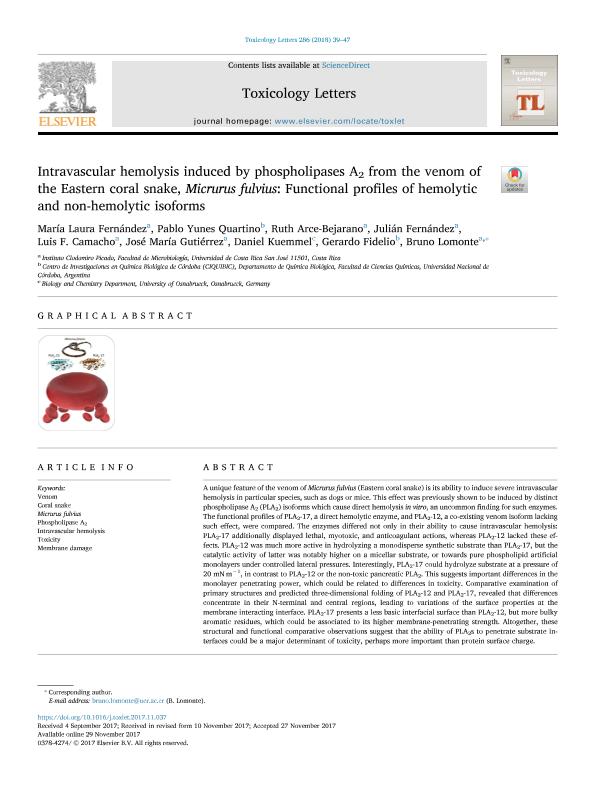Mostrar el registro sencillo del ítem
dc.contributor.author
Fernández, María Laura
dc.contributor.author
Yunes Quartino, Pablo Javier

dc.contributor.author
Arce Bejarano, Ruth
dc.contributor.author
Fernández, Julián
dc.contributor.author
Camacho, Luis F.
dc.contributor.author
Gutiérrez, José María
dc.contributor.author
Kuemmel, Daniel
dc.contributor.author
Fidelio, Gerardo Daniel

dc.contributor.author
Lomonte, Bruno
dc.date.available
2020-01-22T20:58:18Z
dc.date.issued
2018-04
dc.identifier.citation
Fernández, María Laura; Yunes Quartino, Pablo Javier; Arce Bejarano, Ruth; Fernández, Julián; Camacho, Luis F.; et al.; Intravascular hemolysis induced by phospholipases A2 from the venom of the Eastern coral snake, Micrurus fulvius: Functional profiles of hemolytic and non-hemolytic isoforms; Elsevier Ireland; Toxicology Letters; 286; 4-2018; 39-47
dc.identifier.issn
0378-4274
dc.identifier.uri
http://hdl.handle.net/11336/95628
dc.description.abstract
A unique feature of the venom of Micrurus fulvius (Eastern coral snake) is its ability to induce severe intravascular hemolysis in particular species, such as dogs or mice. This effect was previously shown to be induced by distinct phospholipase A2 (PLA2) isoforms which cause direct hemolysis in vitro, an uncommon finding for such enzymes. The functional profiles of PLA2-17, a direct hemolytic enzyme, and PLA2-12, a co-existing venom isoform lacking such effect, were compared. The enzymes differed not only in their ability to cause intravascular hemolysis: PLA2-17 additionally displayed lethal, myotoxic, and anticoagulant actions, whereas PLA2-12 lacked these effects. PLA2-12 was much more active in hydrolyzing a monodisperse synthetic substrate than PLA2-17, but the catalytic activity of latter was notably higher on a micellar substrate, or towards pure phospholipid artificial monolayers under controlled lateral pressures. Interestingly, PLA2-17 could hydrolyze substrate at a pressure of 20 mN m−1, in contrast to PLA2-12 or the non-toxic pancreatic PLA2. This suggests important differences in the monolayer penetrating power, which could be related to differences in toxicity. Comparative examination of primary structures and predicted three-dimensional folding of PLA2-12 and PLA2-17, revealed that differences concentrate in their N-terminal and central regions, leading to variations of the surface properties at the membrane interacting interface. PLA2-17 presents a less basic interfacial surface than PLA2-12, but more bulky aromatic residues, which could be associated to its higher membrane-penetrating strength. Altogether, these structural and functional comparative observations suggest that the ability of PLA2s to penetrate substrate interfaces could be a major determinant of toxicity, perhaps more important than protein surface charge.
dc.format
application/pdf
dc.language.iso
eng
dc.publisher
Elsevier Ireland

dc.rights
info:eu-repo/semantics/openAccess
dc.rights.uri
https://creativecommons.org/licenses/by-nc-sa/2.5/ar/
dc.subject
CORAL SNAKE
dc.subject
INTRAVASCULAR HEMOLYSIS
dc.subject
MEMBRANE DAMAGE
dc.subject
MICRURUS FULVIUS
dc.subject
PHOSPHOLIPASE A2
dc.subject
TOXICITY
dc.subject
VENOM
dc.subject.classification
Bioquímica y Biología Molecular

dc.subject.classification
Ciencias Biológicas

dc.subject.classification
CIENCIAS NATURALES Y EXACTAS

dc.title
Intravascular hemolysis induced by phospholipases A2 from the venom of the Eastern coral snake, Micrurus fulvius: Functional profiles of hemolytic and non-hemolytic isoforms
dc.type
info:eu-repo/semantics/article
dc.type
info:ar-repo/semantics/artículo
dc.type
info:eu-repo/semantics/publishedVersion
dc.date.updated
2019-10-15T15:18:54Z
dc.journal.volume
286
dc.journal.pagination
39-47
dc.journal.pais
Irlanda

dc.journal.ciudad
Shannon
dc.description.fil
Fil: Fernández, María Laura. Universidad de Costa Rica; Costa Rica
dc.description.fil
Fil: Yunes Quartino, Pablo Javier. Consejo Nacional de Investigaciones Científicas y Técnicas. Centro Científico Tecnológico Conicet - Córdoba. Centro de Investigaciones en Química Biológica de Córdoba. Universidad Nacional de Córdoba. Facultad de Ciencias Químicas. Centro de Investigaciones en Química Biológica de Córdoba; Argentina
dc.description.fil
Fil: Arce Bejarano, Ruth. Universidad de Costa Rica; Costa Rica
dc.description.fil
Fil: Fernández, Julián. Universidad de Costa Rica; Costa Rica
dc.description.fil
Fil: Camacho, Luis F.. Universidad de Costa Rica; Costa Rica
dc.description.fil
Fil: Gutiérrez, José María. Universidad de Costa Rica; Costa Rica
dc.description.fil
Fil: Kuemmel, Daniel. Universität Osnabrück; Alemania
dc.description.fil
Fil: Fidelio, Gerardo Daniel. Consejo Nacional de Investigaciones Científicas y Técnicas. Centro Científico Tecnológico Conicet - Córdoba. Centro de Investigaciones en Química Biológica de Córdoba. Universidad Nacional de Córdoba. Facultad de Ciencias Químicas. Centro de Investigaciones en Química Biológica de Córdoba; Argentina
dc.description.fil
Fil: Lomonte, Bruno. Universidad de Costa Rica; Costa Rica
dc.journal.title
Toxicology Letters

dc.relation.alternativeid
info:eu-repo/semantics/altIdentifier/url/https://www.sciencedirect.com/science/article/pii/S0378427417314984
dc.relation.alternativeid
info:eu-repo/semantics/altIdentifier/doi/https://doi.org/10.1016/j.toxlet.2017.11.037
Archivos asociados
